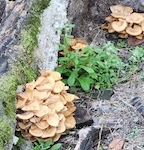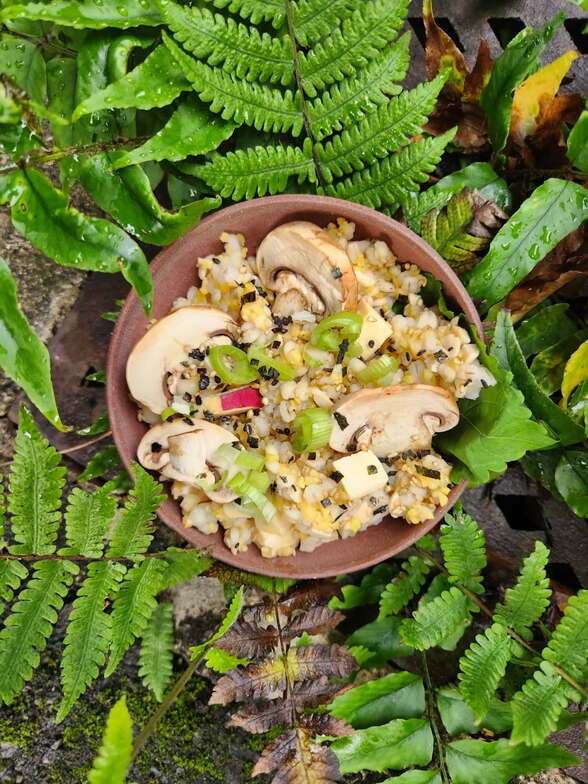Longtime UNS Member, Sharon Meyers, is currently living in Japan for several months. This is a glimpse into her world and journey.
Ah, take a deep breath
eat and drink of the forest
each moment, savored
The mountains that embrace Kyoto are considered sacred, not only because they hold historic temples and shrines, but because they radiate life force energy. Foraged food and drink are often part of the forest bathing experience for those who know the land. Locals exclaim that when you eat sansai/ wild mountain food, you take in the energy of the land itself.
This week I savored this very slow food experience: hiking deep into the mountain forest; finding, selecting, harvesting, then cooking kogomi/ fern, sweet potato and lotus for tempura, sauteed with sesame and a bit of salt; ramps for pickles; bamboo shoots and golden oyster mushrooms for rice. Japanese have been gathering wild food to cook with since ancient times. This is pure food, without help from man at all in
planting, fertilizing or watering – and so very satisfying as well as sustainable.
Guided by a farmer who traces her heritage back hundreds of years in her mountain forest community, I relished this sansai exploration, then our last gathering of flowers, leaves and young needles of evergreen to boil into a tea. What a lovely ritual of bringing us into harmony with the natural world, akin to the traditional Japanese tea ceremony. As a gesture of respect for the mountain, we cupped our hands to literally drink in
the forest from the stream at our feet.
What rituals can you create to connect yourself with the natural world, perhaps in both sharing and closing your day?
Arigato,
Sharon
Garden Chat Recipe
Meaning “wild mountain vegetable,” sansai is a nostalgic word that reflects love of the land, foraging for the land’s bounty. This week, I explored these edible bulbs, roots, shoots and flowers in the mountains north of Kyoto – sustainable, nutritious and delicious if one knows where to look and how to prepare. Here , we present a simple savory dish that is a seasonal staple during autumn. You’ll note lots of alternatives to make this delicious dish with what is easily available for you.
Wild Mountain Sansai Rice
serves 2
Ingredients:
1/4 cup each fresh shitake mushrooms, bamboo shoots and handful of mizuni Japanese basil
(or mushrooms of your choice, canned bamboo shoots and purple Thai basil), sliced thinly
1 sheet tofu skin (or 1/2 cup firm tofu, cubed)
1 cup Japanese rice (short grain rice or Calrose rice)
1 T dashi powder dissolved into 2 cups water
1 T each soy sauce (or Tamari or coconut aminos), mirin (or vinegar with pinch of salt) and
sake (or white wine).
To Make:
-Rinse rice 2 to 3 times until water runs clear (this releases the starch) and set aside.
-Heat dashi water to simmer, then reduce to low; add rice, soy sauce, mirin, sake and pinch of
salt and cook for 15 to 20 minutes until water is absorbed into the rice.
-Layer tofu, bamboo shoots and mizuni atop rice; let sit for 5 minutes, then gently mix and
serve in two bowls.
-Varied toppings make this dish variable: add white or black sesame, furikake rice seasoning
(Trader Joes sells this in a jar, spice section).
Note: The flavors in this dish deepen with time, so it is even tastier the next day.
Let sansai rice cool to room temperature, then keep in fridge for up to 3 days. To reheat, just
sprinkle rice with water, then heat on stove top or microwave.





